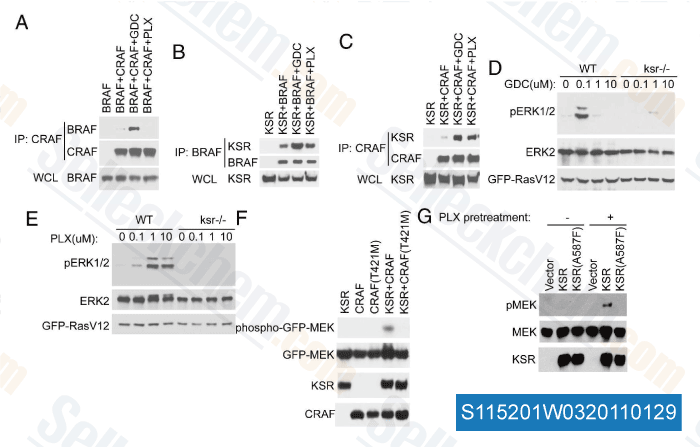|
Toll Free: (877) 796-6397 -- USA and Canada only -- |
Fax: +1-832-582-8590 Orders: +1-832-582-8158 |
Tech Support: +1-832-582-8158 Ext:3 Please provide your Order Number in the email. |
Technical Data
| Formula | C17H14ClF2N3O3S |
|||
| Molecular Weight | 413.83 | CAS No. | 918505-84-7 | |
| Solubility (25°C)* | In vitro | DMSO | 83 mg/mL (200.56 mM) | |
| Water | Insoluble | |||
| Ethanol | Insoluble | |||
|
* <1 mg/ml means slightly soluble or insoluble. * Please note that Selleck tests the solubility of all compounds in-house, and the actual solubility may differ slightly from published values. This is normal and is due to slight batch-to-batch variations. * Room temperature shipping (Stability testing shows this product can be shipped without any cooling measures.) |
||||
Preparing Stock Solutions
Biological Activity
| Description | PLX4720 is a potent and selective inhibitor of B-RafV600E with IC50 of 13 nM in a cell-free assay, equally potent to c-Raf-1(Y340D and Y341D mutations), 10-fold selectivity for B-RafV600E than wild-type B-Raf. | ||||||||
|---|---|---|---|---|---|---|---|---|---|
| Targets |
|
||||||||
| In vitro | PLX-4720 displays >10 times selectivity against wild type B-Raf, and >100 times selectivity over other kinases such as Frk, Src, Fak, FGFR, and Aurora A with IC50 of 1.3-3.4 μM. PLX-4720 significantly inhibits the ERK phosphorylation in cell lines bearing B-RafV600E with IC50 of 14-46 nM, but not the cells with wild-type B-Raf. PLX-4720 significantly inhibits the growth of tumor cell lines bearing the B-RafV600E oncogene, such as COLO205, A375, WM2664, and COLO829 with GI50 of 0.31 μM, 0.50 μM, 1.5 μM, and 1.7 μM, respectively. In addition, PLX-4720 treatment at 1 μM induces cell cycle arrest and apoptosis exclusively in the B-RafV600E-positive 1205Lu cells, but not in the B-Raf wild-type C8161 cells. [1] PLX-4720 treatment (10 μM) significantly induces >14-fold expression of BIM in the PTEN+ cells, compared with the PTEN- cell lines (4-fold), giving an explanation of the resistance of PTEN- cells to PLX-4720-induced apoptosis. [2] | ||||||||
| In vivo | Oral administration of PLX-4720 at 20 mg/kg/day induces significant tumor growth delays and regressions in B-RafV600E-dependent COLO205 tumor xenografts, without obvious adverse effects in mice even at dose of 1 g/kg. PLX-4720 at 100 mg/kg twice daily almost completely eliminates the 1205Lu xenografts bearing B-RafV600E, while has no activity against C8161 xenografts bearing wild-type B-Raf. The anti-tumor effects of PLX-4720 correlate with the blockade of MAPK pathway in those cells harboring the V600E mutation. [1] PLX-4720 treatment at 30 mg/kg/day significant inhibits the tumor growth of 8505c xenografts by >90%, and dramatically decreases distant lung metastases. [3] |
Protocol (from reference)
| Kinase Assay:[1] |
|
|---|---|
| Cell Assay:[1] |
|
| Animal Study:[1] |
|
References
Customer Product Validation

-
Data from [Data independently produced by Cancer Discov, 2013, 3, 350-62]

-
Data from [Data independently produced by Genes Dev, 2012, 26, 1055-69]

-
Data from [Proc Natl Acad Sci USA, 2011, 108, 6067-6072]

-
Data from [Cancer Res, 2011, 71, 2750-2760]
Selleck's PLX-4720 has been cited by 203 publications
| Noncanonical role of Golgi-associated macrophage TAZ in chronic inflammation and tumorigenesis [ Sci Adv, 2025, 11(4):eadq2395] | PubMed: 39841821 |
| The ribotoxic stress response drives UV-mediated cell death [ Cell, 2024, 187(14):3652-3670.e40] | PubMed: 38843833 |
| Tracking the EMT-like phenotype switching during targeted therapy in melanoma by analyzing extracellular vesicle phenotypes [ Biosens Bioelectron, 2024, 10.1016/j.bios.2023.115819] | PubMed: 37952322 |
| Mcl-1 mediates intrinsic resistance to RAF inhibitors in mutant BRAF papillary thyroid carcinoma [ Cell Death Discov, 2024, 10(1):175] | PubMed: 38622136 |
| The ERK5 pathway in BRAFV600E melanoma cells plays a role in development of acquired resistance to dabrafenib but not vemurafenib [ FEBS Lett, 2024, 10.1002/1873-3468.14960] | PubMed: 38977937 |
| Executioner caspases restrict mitochondrial RNA-driven Type I IFN induction during chemotherapy-induced apoptosis [ Nat Commun, 2023, 14(1):1399] | PubMed: 36918588 |
| Executioner caspases restrict mitochondrial RNA-driven Type I IFN induction during chemotherapy-induced apoptosis [ Nat Commun, 2023, 14(1):1399] | PubMed: 36918588 |
| TFEB inhibition induces melanoma shut-down by blocking the cell cycle and rewiring metabolism [ Cell Death Dis, 2023, 14(5):314] | PubMed: 37160873 |
| Inhibition of TGF-β signaling, invasion, and growth of cutaneous squamous cell carcinoma by PLX8394 [ Oncogene, 2023, 10.1038/s41388-023-02863-8] | PubMed: 37864034 |
| WNT5A-ROR2 axis mediates VEGF dependence of BRAF mutant melanoma [ Cell Oncol (Dordr), 2023, 46(2):391-407] | PubMed: 36539575 |
RETURN POLICY
Selleck Chemical’s Unconditional Return Policy ensures a smooth online shopping experience for our customers. If you are in any way unsatisfied with your purchase, you may return any item(s) within 7 days of receiving it. In the event of product quality issues, either protocol related or product related problems, you may return any item(s) within 365 days from the original purchase date. Please follow the instructions below when returning products.
SHIPPING AND STORAGE
Selleck products are transported at room temperature. If you receive the product at room temperature, please rest assured, the Selleck Quality Inspection Department has conducted experiments to verify that the normal temperature placement of one month will not affect the biological activity of powder products. After collecting, please store the product according to the requirements described in the datasheet. Most Selleck products are stable under the recommended conditions.
NOT FOR HUMAN, VETERINARY DIAGNOSTIC OR THERAPEUTIC USE.
